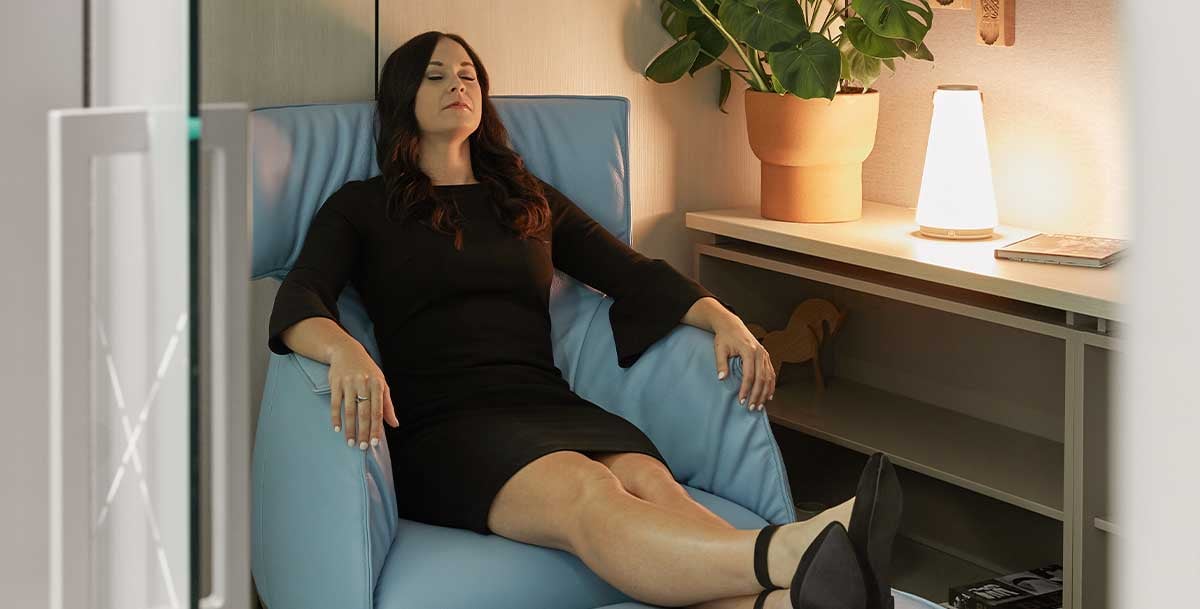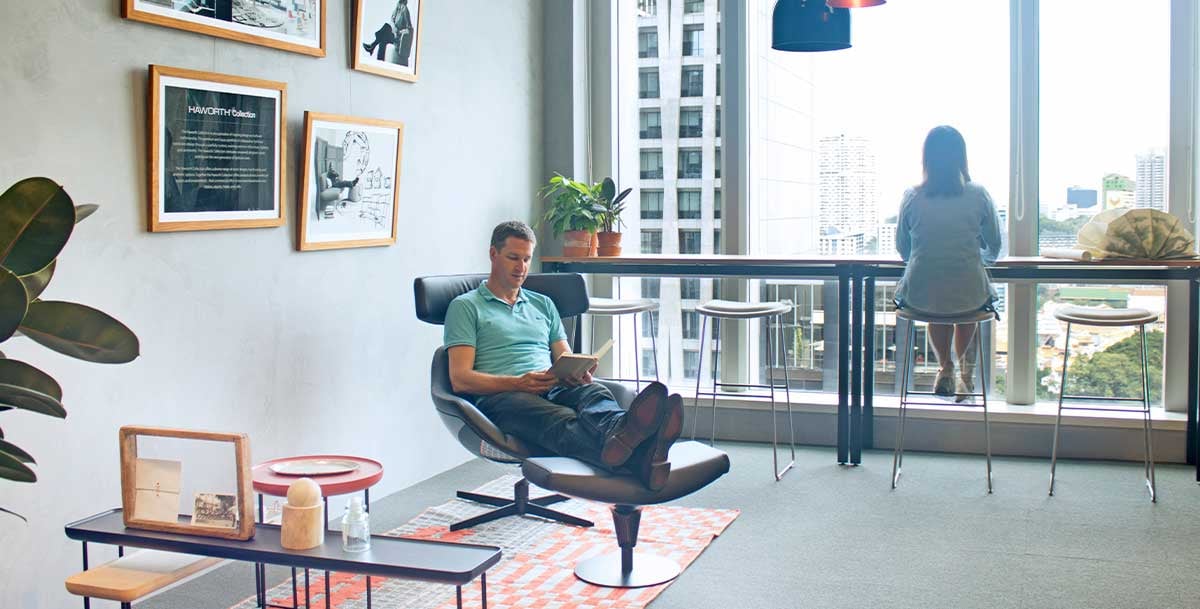
Mindfulness is the ability to be fully aware of where we are and what we’re doing in the moment. Promoting mindfulness in the workplace—and the home office—increases productivity, improves employee satisfaction, and generally reduces stress levels throughout an organization. According to Science Daily, injecting a corporate culture of mindfulness not only improves focus but the ability to manage stress and how employees work together.
The Productivity Gap
After nearly two years of working from home, juggling our kids’ schooling from home, and navigating a return to in-person or hybrid office schedules, one thing is clear: American workers are more stressed than ever before.
The ongoing health crisis has served to highlight issues that already existed. A false belief in multitasking and the blurring of work hours into nights and weekends have caused many of us to have sleep issues, lack of focus, and, in many cases, a feeling of constant exhaustion. Employee stress can also negatively affect your company's bottom line.
According to Gallup’s recent State of the Global Workplace report, workers in the U.S. number among the most stressed employees in the world. American and Canadian workers (whose data are combined in the Gallup study) ranked highest for daily stress levels of all the groups surveyed. About 57% of these workers reported feeling stress daily, an increase of eight points from the previous year’s survey.

Mindfulness is a Valuable Management Tool
As businesses expect higher productivity, practicing mindfulness may seem counter-intuitive. Yet, neuroscience has proven that successful multitasking is impossible. Moving from project-to-project limits our productivity because rather than finishing one task at a time, we waste time and energy by revisiting the ones we have already started.
While we may think we’re good at checking things off our to-do lists, what we’ve really gotten good at is “continuous partial attention.” Writer Linda Stone coined that term back in 1998 and defined it as “paying simultaneous attention to a number of courses of incoming information but at a superficial level.”
Related: Download The Workspace Nudge™ for Well-Being
Learn how design features, interior architecture, furnishings, and technology can be designed to “nudge” people towards behaviors that positively influence their well-being.
However, when you practice mindfulness, you can go deeper than that superficial level. You learn to focus your attention on what is right in front of you, blocking out distractions, thinking more clearly, and ultimately feeling better both mentally and physically.
According to the Mayo Clinic, mindfulness involves breathing methods, guided imagery, and other meditative practices to help relax the body and mind. We’ve identified four key steps you can take to support mindfulness in your workplace.
Environmental control and legible space can provide healthy nudges for employees. This graphic is excerpted from The Workspace Nudge™ for Well-Being, produced by Haworth.
Supporting Mindfulness Within the Workplace
1. Encourage breaks
Short mindfulness breaks throughout the day help people become clearer thinkers and focus more on what’s important. Science has discovered that too much mental churning is counterproductive. When you lurch from one thing to the next, constantly scheming or reacting to incoming fires, your mind becomes exhausted. This exhaustion then can cause you to get sloppy and make bad decisions.
The act of stopping, even for just a few seconds, is a source of strength, not weakness. Pausing can be a key ingredient of creativity and innovation.
Think about it. How many times have you come up with a great idea or an answer to a problem while you were in the shower, taking a run, or relaxing in bed? The best solutions come when you allow your subconscious mind to take over. It is when we move away from the problem that we tend to have those “aha” moments.
Takeaway: Encourage your employees to get off their screens and away from their desks at regular intervals throughout the day. Steer away from over-time expectations and respect their downtime by not sending emails and messages during off-work hours.
2. Offer meditation classes
General Mills, Aetna, Intel, Procter & Gamble, and Target are a few of the growing number of companies that offer meditation classes for their workers. General Mills even provides meditation rooms -- complete with zafus and yoga mats -- in every campus building of their company headquarters near Milwaukee.
These U.S. companies believe meditation brings mindfulness, not as a spiritual exercise but as something that enhances your creativity and innovation and can help make you a better leader. And there is science that backs up these findings.
Studies by neuroscientists demonstrate that mindfulness affects the areas of the brain related to complex thinking, perception, pain tolerance, body awareness, emotion regulation, introspection, and sense of self.
Leadership and change consultant Christina Congleton puts it this way in the Harvard Business Review, “Mindfulness should no longer be considered ‘a nice-to-have for executives. It’s a ‘must-have’: a way to keep our brains healthy, to support self-regulation and effective decision-making capabilities, and to protect ourselves from toxic stress…When we take a seat, take a breath, and commit to being mindful, particularly when we gather with others who are doing the same, we have the potential to be changed.”
Takeaway: Offer in-person and online classes in yoga, relaxation, and meditation as part of your employee benefits package. Allocate space in your offices where employees can participate in these classes or meditate on their own during a workday break.

3. Provide a low-stress physical environment
Open, collaborative workspaces were all the rage before the pandemic. However, in addition to the lack of social distancing they provide in a post-COVID world, these communal spaces may cause more stress than creativity.
It’s time to rethink your office environment with mindfulness as a priority. Here are some ideas to consider:
Provide quiet zones away from the hustle and bustle of the office where employees can go to think or just relax. Consider ways you can improve poor acoustics in open spaces.
-
- Offer green spaces. Numerous studies show that we feel calmer and more relaxed in nature. Find ways to bring natural light and plants indoors and add outdoor seating and walking areas wherever possible.
- Keep things comfortable. Monitor office temperature and lighting levels and recognize how these needs change throughout the year. Look for ways to increase the amount of natural light in your space throughout the day.
- Invest in furniture that is both comfortable and ergonomic. Some studies have called sitting the new smoking in terms of its negative health impact. Review ways you can lower employee stress with thoughtfully designed, supportive desks and chairs.
Takeaway: Focus on initiating furniture and room design changes that reduce stress and support mindfulness in the workplace. Apply this across your organization—from hub to home.

4. Share ways workers can practice mindfulness wherever they are
An increasing body of scientific evidence shows that the more we practice mindfulness, the better we get at it. Sara Lazar, a neuroscientist at Harvard Medical School, has used MRI technology to show that mindful activities like meditation and yoga can essentially re-wire the brain, altering how you react to stressful situations, helping you feel calmer and more in control.
The type of research is having an impact. Schools, prisons, the U.S. Forest Service, and the U.S. Marines are actively using mindfulness as a way to help with PTSD and psychological change.
Takeaway: In addition to group classes, enable your workers to monitor their stress levels and work on mindful techniques at home. For example, the Headspace app offers daily challenges and content tailored to help with a range of stress factors.
Mindfulness Can Improve
Remember when we all longed for a post-COVID return to normal? That “back to normal” fantasy may be just that – a fantasy. The pandemic has created a new, uncertain normal. One that focuses on our wellness! The challenges of 2020 and 2021 have forced us to confront our need for mindfulness. And with this knowledge comes an opportunity for a change for the better.
We can create thoughtful work arrangements that are healthier for us both mentally and physically. We can say no to the negative results of multitasking and say yes to embracing what is right in front of us. And we believe that new “normal” sounds much better than what we had before.






